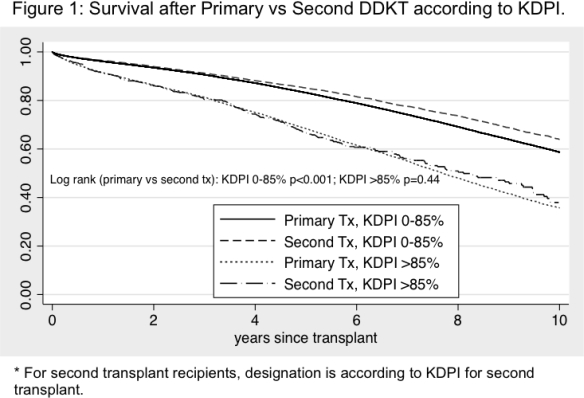Survival After Second Kidney Transplant: Are We Being Good Stewards?
University of Texas Health Science Center, San Antonio.
Meeting: 2016 American Transplant Congress
Abstract number: B197
Keywords: Age factors, Kidney transplantation, Retransplantation, Survival
Session Information
Session Name: Poster Session B: Kidney Transplantation: KDPI, HCV/Matching, Donor Age
Session Type: Poster Session
Date: Sunday, June 12, 2016
Session Time: 6:00pm-7:00pm
 Presentation Time: 6:00pm-7:00pm
Presentation Time: 6:00pm-7:00pm
Location: Halls C&D
BACKGROUND: Primary kidney transplant is associated with increased life years compared with dialysis. Comparable patient survival between primary (1KT) and second kidney transplants (2KT) has been established in patients with lower immunological risks. Given organ scarcity, we aimed to compare the survival benefit of 2KT with 1KT according to differences in recipient age and donor type and quality.
METHODS: National UNOS data from 2000-2014 for kidney only recipients of 1KT (n=207,811) and 2KT (n=20,829) was analyzed to compare patient survival according to recipient age, donor type (living (LD) vs deceased donor (DD)), and donor quality (KDPI 0-85% vs KDPI>85% for DD transplants).
RESULTS: Unadjusted patient survival between 1KT and 2KT was equivalent (each 97% at 1 yr), but 2KT was associated with a 13% increased mortality hazard (HR=1.13, 95% CI=1.05-1.21) after adjusting for recipient age, race, gender, BMI, CPRA, and diabetes. 2KT recipients were younger (1KT 49±16 yrs old vs 2KT 44±14 yrs old, p<0.001) and had less diabetes (1KT 31% vs 2KT 20%, p<0.001). 48% and 12% of 2KT recipients were 41-60 years old and >60 years old, respectively. The median life years after transplant was only slightly less for 2KT compared with 1KT (1KT 12 yrs vs 2KT 11 yrs for recipients 41-60 yrs old) and (1KT 8 yrs vs 2KT 7 yrs for recipients >60 yrs old). LD 1KT and 2KT had comparable survival. For DDKT, survival was higher for 2KT than 1KT; specifically survival was significantly better for 2KT compared with 1KT in KDPI 0-85% DDKT recipients (see Figure1).
CONCLUSIONS: There was evidence of greater selection bias in individuals who receive 2KT causing adjusted patient mortality to be increased after 2KT compared with 1KT. Still given current selection practices, patient survival and median life years after transplant were very comparable between 2KT and 1KT recipients. Improved survival according to donor type was seen for 2KT compared with 1KT from deceased donors and specifically among recipients of KDPI 0-85% grafts. This evidence suggests that the use of scarce organs for 2KT recipients according to current practices yields equitable results.

CITATION INFORMATION: Jay C, Pugh J, Halff G, Abrahamian G, Cigarroa F, Stephens N, Washburn K. Survival After Second Kidney Transplant: Are We Being Good Stewards? Am J Transplant. 2016;16 (suppl 3).
To cite this abstract in AMA style:
Jay C, Pugh J, Halff G, Abrahamian G, Cigarroa F, Stephens N, Washburn K. Survival After Second Kidney Transplant: Are We Being Good Stewards? [abstract]. Am J Transplant. 2016; 16 (suppl 3). https://atcmeetingabstracts.com/abstract/survival-after-second-kidney-transplant-are-we-being-good-stewards/. Accessed December 14, 2025.« Back to 2016 American Transplant Congress
